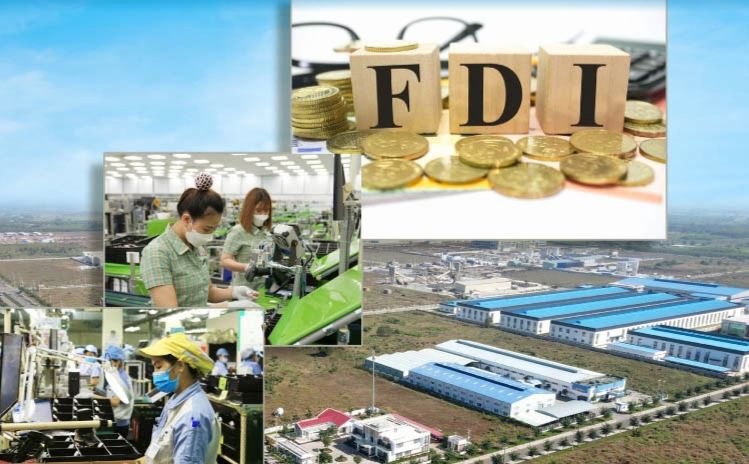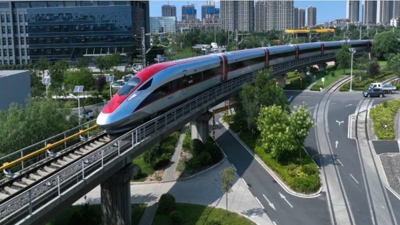Nghe An province attracts high‑quality FDI
North-central Nghe An province has experienced a meteoric rise over recent years to become a key FDI destination.

According to the former Ministry of Planning and Investment, now part of the Ministry of Finance, north-central Nghe An province attracted over $1.74 billion in FDI in 2024, up 8.8 per cent year-on-year. The province licensed 19 new projects worth $867.8 million and saw additional capital of $881.76 million into 14 existing projects, securing its spot in the top 8 nationwide for the third consecutive year.
In early 2025, Nghe An approved the VSIP Nghe An 3 industrial park project from Singapore’s Sembcorp, covering 181 ha with $2.5 million in capital, following VSIP 1 and 2. Meanwhile, Thailand’s WHA Group received approval for the second phase of the WHA Industrial Park, on 183.37 ha and with $50 million in capital, from the Prime Minister under Decision No. 1706/QD-TTg dated December 31, 2024. Both aim to develop clean, well-connected industrial infrastructure to attract high-quality secondary investors.
From underdog to FDI destination
Nghe An’s rise has been striking. Once considered a lesser-known player on Vietnam’s investment map, it has rapidly emerged as one of the country’s most compelling destinations for FDI. With the largest land area in Vietnam, the province offers vast and affordable industrial land, making it a competitive area compared to high-demand localities such as Hanoi and the northern port city of Hai Phong and nearby Quang Ninh province.
Strategically positioned within the Northern Technology Corridor, which accounts for 75 per cent of Vietnam’s high-tech enterprises, Nghe An also benefits from a population of 3.4 million, strong educational institutions, and a growing pool of skilled workers.
Back in 2017, Nghe An ranked just 33rd nationwide in FDI attraction. By 2023-2024, however, it had surged into the top 8, and has begun accelerating its industrial land development strategy and policy reforms, paving the way for a new wave of strategic investments. It now hosts 169 valid FDI projects with total registered capital of $5.68 billion; a testament to both Vietnam’s open-door FDI policy and the province’s proactive approach to investor engagement.
Crucially, the province’s forward-looking policies have laid the foundation for a dramatic transformation in its FDI profile. Notably, Nghe An has expanded its planned industrial land area from 20,776 ha to 79,731 ha, a 3.8-fold increase. By the end of this year, it is expected to offer approximately 1,500 ha of clean, ready-to-lease land to foreign investors.
Policy incentives and administrative reforms
To enhance its appeal among foreign investors, Nghe An has actively rolled out a comprehensive range of investor-friendly policies and incentives, positioning itself as one of Vietnam’s most dynamic destinations for FDI.
The province has accelerated administrative reforms in recent years, significantly reducing processing times and streamlining investment procedures. The establishment of the Southeast Economic Zone (SEZ) has provided a more favorable legal and operational framework, enabling investors to handle licensing and documentation with greater efficiency.
Nghe An also conducts regular investment promotion campaigns, both domestically and internationally, while capitalizing on its competitive advantage of low-cost, high-quality human resources.
The province is home to six universities, eleven colleges, and 70 vocational training institutions, enabling it to supply over 45,000 workers annually, more than 65 per cent of whom are trained; a key advantage for FDI enterprises seeking to establish manufacturing operations.
In addition to national-level incentives, Nghe An also offers four key provincial-level support programs aimed at reducing initial investment costs.
First, investment procedure support. The provincial budget covers up to 50 per cent of investment procedure costs, to a maximum of VND200 million ($8,000) per project.
Second, land leveling support. Up to 50 per cent of site leveling costs are subsidized in accordance with the Nghe An Provincial People’s Council’s Resolution No. 05/2021/NQ-HDND dated August 13, 2021, on investment support policies in Nghe An in the 2021-2025 period.
Third, infrastructure development support. Financial assistance is provided for the construction of roads and drainage systems up to the boundary of the project site.
Fourth, worker training support. A one-time subsidy of VND2 million ($80) per worker is available to help businesses train new employees.
These incentives support Nghe An’s strategic shift from broad-based investment to high-value, quality FDI, with a bold target of $10 billion in FDI by 2028, particularly in high-tech, smart manufacturing and environmentally-sustainable industries.
Solid infrastructure amid challenges
Nghe An’s well-developed transport and logistics infrastructure is one of the key pillars in its strategy to attract FDI. The province boasts a comprehensive road network, with 16 national highways, including critical routes such as National Highways 1A, 7, and 48, along with 39 provincial roads. This integrated network ensures seamless connectivity across the province and to other major economic hubs in Vietnam.
Complementing the road network is the North-South railway line, which runs for 94 km through Nghe An, and an 82 km stretch of coastline featuring Cua Lo and Dong Hoi deep-water ports, which are capable of berthing vessels of up to 30,000 tons, significantly enhancing freight handling capacity for industrial and export-oriented enterprises.
Vinh International Airport also plays a strategic role, offering direct flights to Hanoi, Ho Chi Minh City, Da Nang, and international destinations such as Thailand, Singapore, and Japan, providing rapid connectivity for investors and businesses alike.
However, despite its growing appeal, Nghe An still faces challenges, particularly in infrastructure and workforce readiness.
Capital flows also remain largely concentrated in large-scale industrial manufacturing. Sectors where Nghe An holds untapped potential - such as high-tech agriculture, value-added product chains, marine tourism, eco-tourism, and community-based tourism - have yet to attract significant investment. Unlocking these areas will be key to ensuring more balanced and sustainable economic development aligned with the province’s natural advantages and competitiveness.
FDI roadmap
From a modest player to a rising star on Vietnam’s FDI map, Nghe An is steadily transforming into a strategic engine of growth in the north-central region. The province’s long-term vision, green industrial development, and investor-friendly reforms are laying a solid foundation for a breakthrough phase in foreign investment attraction by 2030.
With a strong emphasis on high-tech and sustainable manufacturing, the provincial roadmap for 2025-2030 outlines several key priorities. To meet the demands of large-scale, high-value projects, Nghe An is accelerating investment in core infrastructure. These efforts include the development of deep-water ports to enhance regional logistics and global connectivity; the expansion and modernization of Vinh International Airport, with runway upgrades scheduled from July to December this year; and ongoing improvements to road, rail, and logistics corridors connecting Nghe An with key economic zones in northern and central Vietnam.
The province is also scaling up the supply of clean, ready-built industrial land. This includes the second phase of the WHA Industrial Park, with further expansion already planned; VSIP Nghe An 3, on 181 ha; and the modernization of existing clusters such as Nam Cam and Dong Hoi, meeting international standards for smart, eco-friendly manufacturing.
With streamlined investor support mechanisms and a proactive provincial government, Nghe An has set an ambitious target of attracting $10 billion in cumulative FDI by 2028. The province is firmly focused on high-tech industries, smart manufacturing, and green growth, positioning itself as a key driver in Vietnam’s next-generation industrial landscape.
|
From the perspective of a long-term investor in Vietnam, since 2017, as the WHA Corporation enters a new phase of expansion of its industrial park in Nghe An, Ms. Jareeporn Jarukornsakul, Chairwoman of the Executive Committee and Group CEO, believes the province is emerging as a magnet for smart, eco-friendly manufacturing. WHA’s journey in Nghe An began in 2017, when the province ranked just 33rd nationwide in terms of FDI attraction. Today, thanks in part to WHA’s presence and investment in industrial infrastructure, Nghe An is ranked among the top investment destinations in the country. “Our industrial parks have been instrumental in elevating Nghe An’s national profile,” she affirmed. WHA’s competitive edge lies in its smart eco industrial park model, an integrated development approach that meets international infrastructure standards while prioritizing environmental sustainability. Key features already operational in Nghe An include a chemical-free biological wastewater treatment system that minimizes environmental impact; renewable energy systems, including solar power for both WHA’s operations and its tenants; and a centralized control room for real-time monitoring of environmental indicators such as air and water quality, traffic, and safety metrics. “Our parks are anchored in three core pillars: world-class design and utilities, operational reliability, and environmental care,” Ms. Jarukornsakul explained. “These innovations not only support WHA’s sustainability goals but also enable our customers to meet increasingly stringent global ESG expectations.” To date, WHA has attracted over $1.3 billion in investment from global manufacturers, including Goertek, Foxconn, and Sunny Optical. “This momentum is the result of close and effective cooperation with provincial authorities, from the People’s Committee and Dong Nam Economic Zone Authority to district and commune-level leadership,” she added. Riding this wave of investor confidence, WHA has secured approval for a 184 ha expansion, with site clearance scheduled to begin this year. “And this is just the beginning,” she said. “We are committed to scaling up our investment in Nghe An in partnership with the local government.” |
(* )Dr. Nguyen Thi Bich Hang is a lecturer at the Finance and Banking Department, Nghe An University







